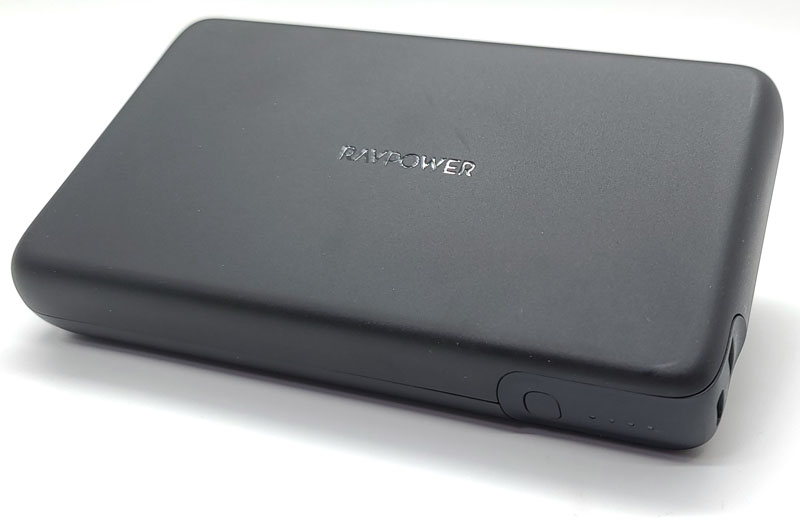
REVIEW – Power-hungry electronics need a boost from time to time, even when you’re not near an outlet. Mobile power banks have helped out, but with power demands increasing, sometimes they just can’t supply enough fast enough. RAVPower has just released a new power bank in their PD Pioneer line that can provide enough power to be able to recharge your laptop, Macbook, iPad, or iPhone 12.
What is it?
The RAVPower PD Pioneer RP-PB232 is a two-port portable power bank capable of charging just about anything that can charge via USB, including USB-C PD (power delivery)capable devices.
What’s in the box?
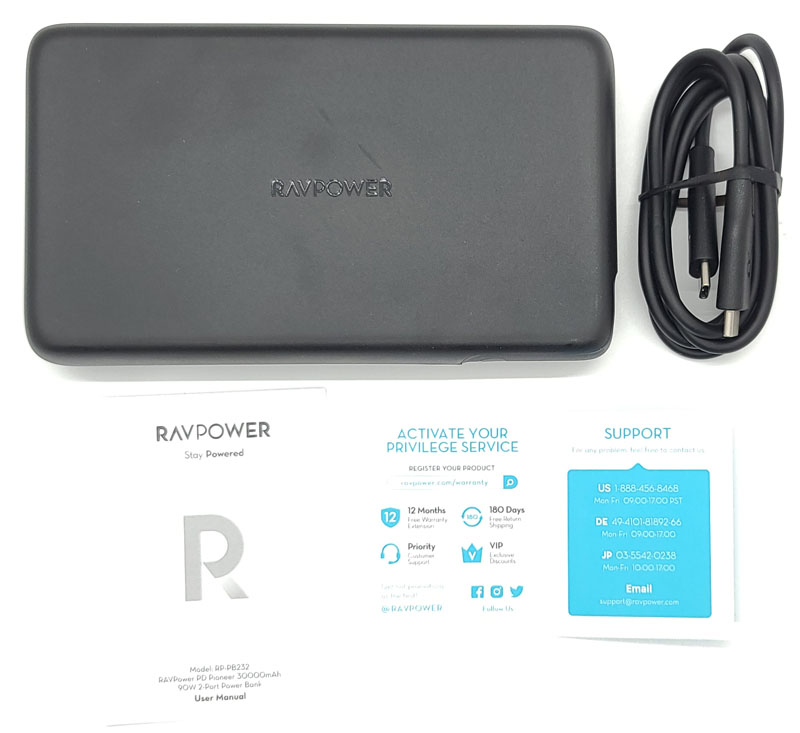
- Power bank
- USB-C to USB-C cable
- User manual
- Thank you card
Hardware specs
- Dimensions: 5.98 x 3.54 x 0.98 inches
- Weight: 1.3lbs
- Batteries: LG 21700 cells
- Battery capacity: 30000mAh / 108.9Wh
- Enough capacity to recharge the following:
- iPhone 12 6.3 times
- Galaxy S20 4.5 times
- iPad Pro2020 2.5 times
- 15.4inch Macbook Pro 1 time
- Enough capacity to recharge the following:
- Inbound power delivery (PD): Supports 60W for rapid recharging in 2.5 hours
- Outbound power: 65W via USB-C PD devices + 18W USB-A iSmart for 83W total
- Ports: 1 – USB-C PD port; 1 – USB-A iSmart port
Design and features
The power bank is covered in black (or very dark gray) matte-finished high-impact plastic. At 1.3lbs, it feels hefty because, well, it is. It is very solidly built.
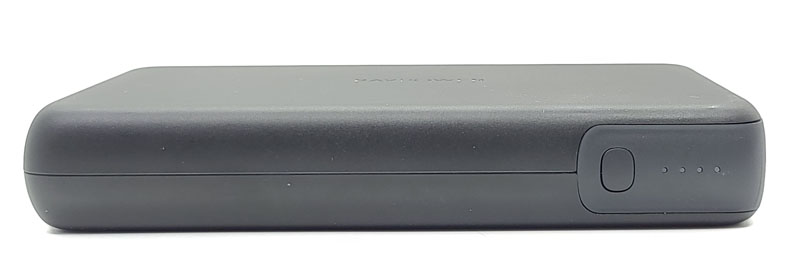 Along the side, there is a power button that also serves as a battery check button. Battery status is reported in 25% increments by blue LEDs. When you press the button, if the pack is discharging (charging something else), the LED(s) will be on steady. When you are charging the battery pack, one LED will be flashing rest will be on or off, depending on charge level. For example, at 0%-24%, one LED will be flashing. At 25%-49%, one LED will be lit and one flashing. At 50%-74%, two LEDs will be lit and one flashing. At 75%-99%, three will be lit and one flashing. Once the pack is fully charged, all four will be lit.
Along the side, there is a power button that also serves as a battery check button. Battery status is reported in 25% increments by blue LEDs. When you press the button, if the pack is discharging (charging something else), the LED(s) will be on steady. When you are charging the battery pack, one LED will be flashing rest will be on or off, depending on charge level. For example, at 0%-24%, one LED will be flashing. At 25%-49%, one LED will be lit and one flashing. At 50%-74%, two LEDs will be lit and one flashing. At 75%-99%, three will be lit and one flashing. Once the pack is fully charged, all four will be lit.
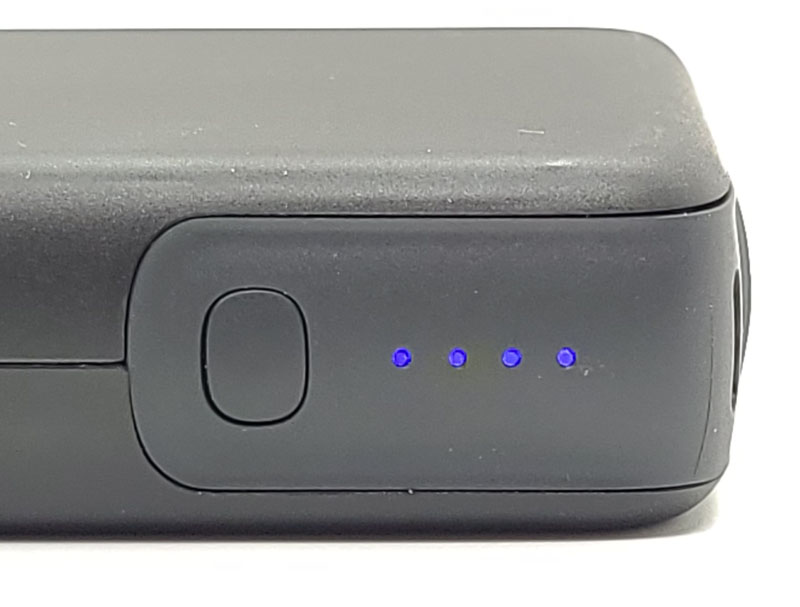
Around the corner from the button and LED, we find the two ports – a USB-C PD port and a USB-A iSmart port.
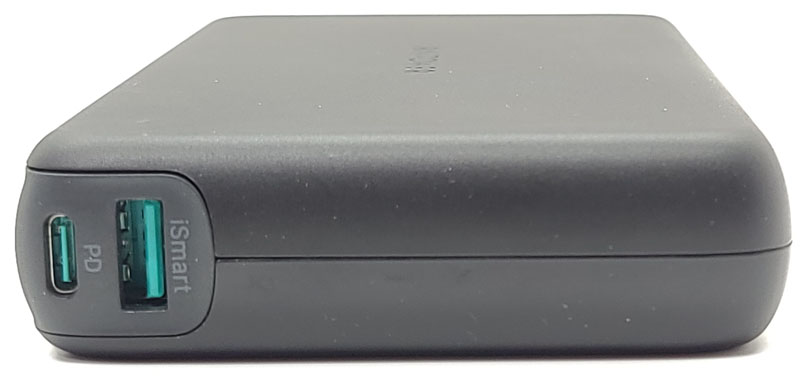
The ports are spaced nicely so it is easy to insert cables.
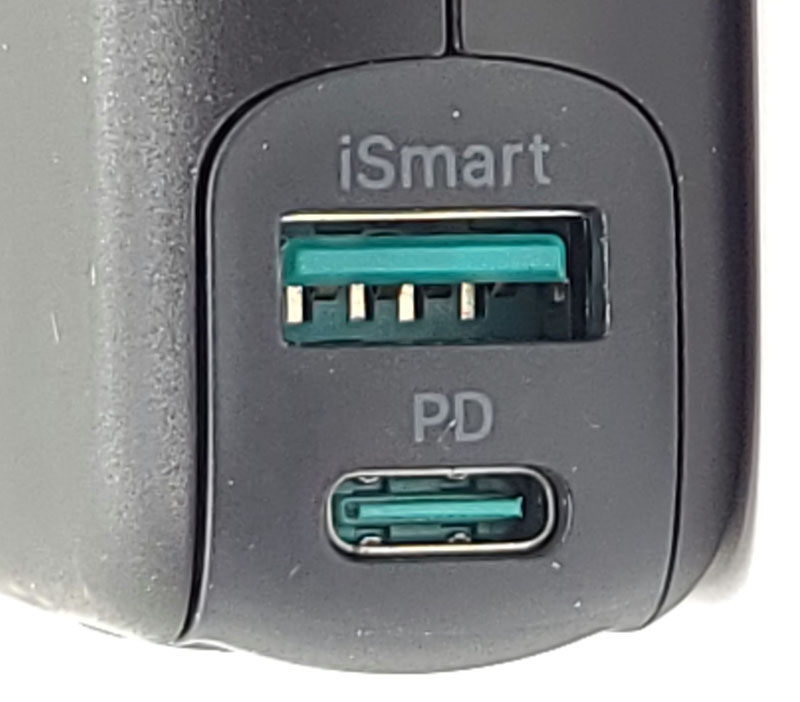
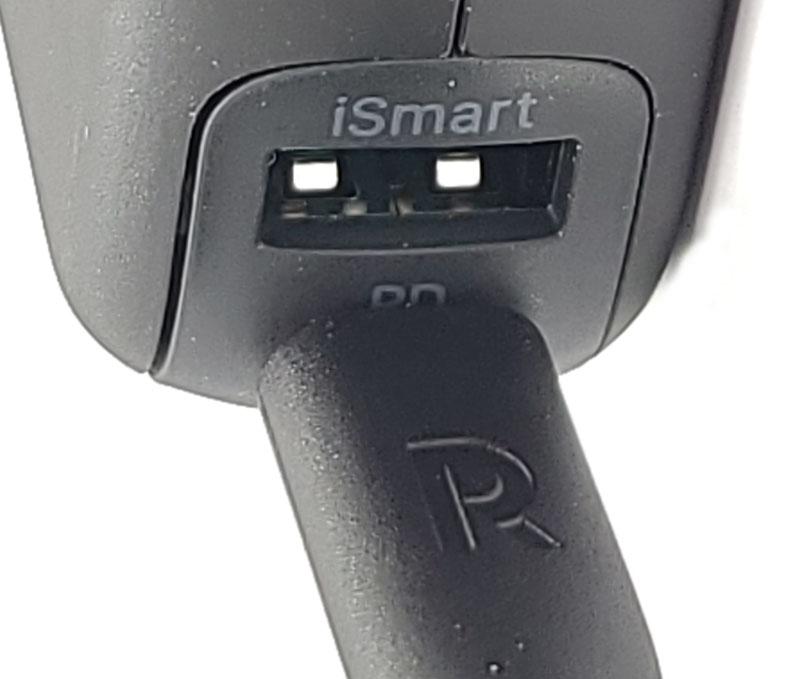
Setup
Other than charging the power bank, there isn’t any setup to do.
Performance
After charging the pack, I decided to try using it to charge my Microsoft Surface Book 2 laptop. This laptop is designed to charge with Microsoft’s proprietary connector but can accept power via USB-C PD. I plugged in the pack and was concerned as the laptop reported the following:
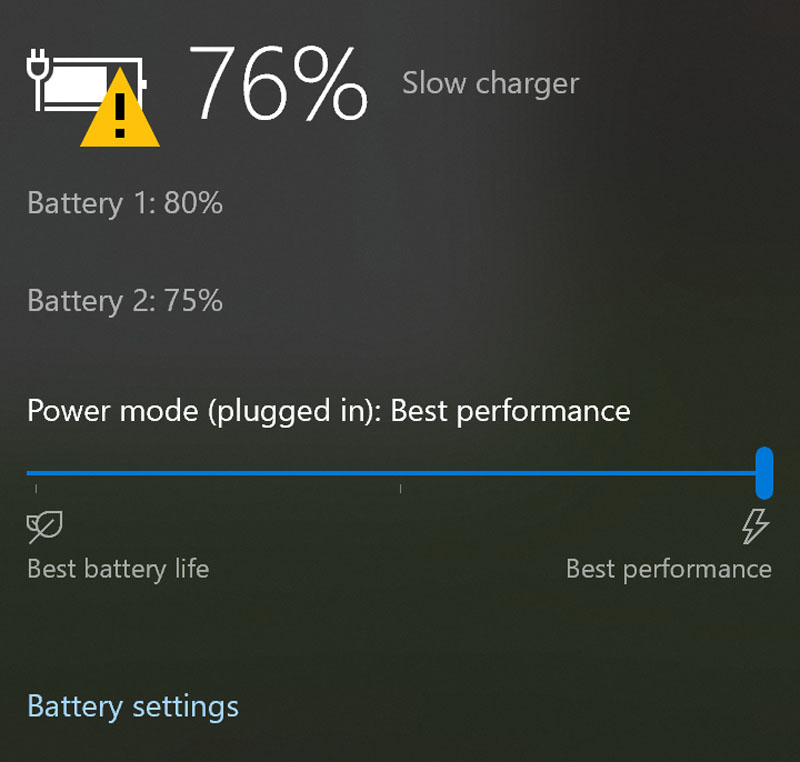
A slow charger! Oh, the horror! But, when I looked more closely in the battery settings, it said that it would be fully charged in about 26 minutes. I then went and plugged in the laptop to my factory charger and it gave the same estimate. So, while the laptop reports that charging is “slow”, it seems to be working just fine.
I plugged the pack into my wife’s Lenovo Yoga 7i. That laptop charges via USB-C PD natively. The pack delivered power as expected and was able to successfully recharge the laptop.
In use, with about 75% capacity, I was able to take my laptop from about 50% charge to 97% in about 45-50 minutes and I still had some charge left in the power bank.
This is a great thing for us. Our living room furniture is in the middle of the room, not near any walls. Unfortunately, when our home was built, the original owner didn’t think to have the builder put in floor plugs under the presumptive couch location. This means we have no power available at our living room furniture’s location. No powered recliner for me! But, that also means that if our laptop batteries are on their last legs, we either have to stop what we’re doing or stretch power cords across the floor, creating a tripping hazard. Now, with the RAVPower power bank, we can just plug in and finish what we’re doing, and then plug in the power bank overnight. It’s a little thing but it sure makes a big difference.
Plugging it into my Samsung Galaxy S20 Ultra triggered my phone’s “Super Fast Charging 2.0” mode. Super Fast Charging pulls a full 25W from the power bank, charging the phone at its fastest possible rate. When I plugged in a USB-A to USB-C cable into the iSmart port and used that to charge my phone, it charged at Samsung’s fast charging rate.
iSmart is RAVPower’s term for their adaptive charging technology.
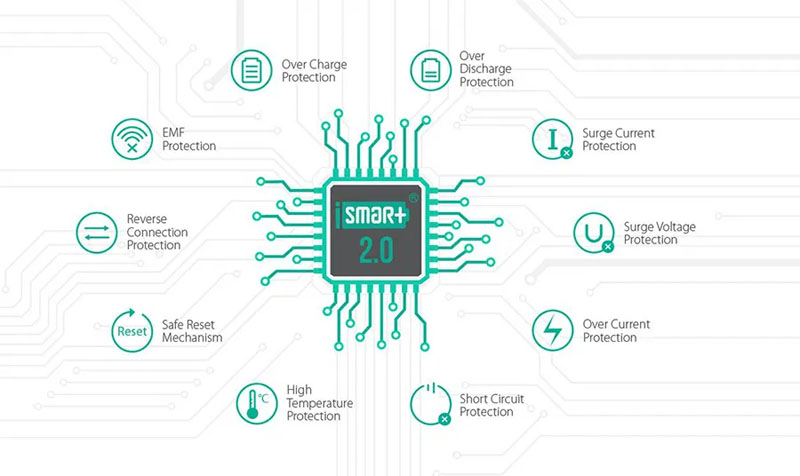
It allows you to charge different types of devices with different current requirements, all from the same charger. This power bank brings portability to that technology. It offers flexibility to your charging and supports Samsung’s fast charge mode from the iSmart port.
For recharging the power bank, you can use just about any USB charger and use a USB-C cable. If you have a 60W charger with a USB-C PD port like this or this, you can recharge the power bank in only 2.5 hours. That’s pretty quick for a bank this large. Plus, you can still leverage the USB-A port to charge something else at the same time. I should note that you should use a high-quality USB cable to achieve fast charging speeds. For this review, I used a Spigen Essential 3-in-1 USB charge/sync cable.
After discharging the power bank to less than 25% charged, I was able to fully recharge it in under 2.5 hours with a 45W USB-C PD charger.
RAVPower talks about this being the perfect travel power bank, and I agree with that sentiment, but…this power bank is rated at 108.9Wh. This is a problem as the FAA doesn’t allow lithium batteries with capacities over 100Wh on airplanes.
Here is some information from the FAA’s website:
Spare (uninstalled) lithium-ion and lithium metal batteries, including power banks and cell phone battery charging cases, must be carried in carry-on baggage only. When a carry-on bag is checked at the gate or at planeside, all spare lithium batteries and power banks must be removed from the bag and kept with the passenger in the aircraft cabin. The battery terminals must be protected from short circuit.
Size limits: Lithium metal (non-rechargeable) batteries are limited to 2 grams of lithium per battery. Lithium-ion (rechargeable) batteries are limited to a rating of 100 Wh per battery. These limits allow for nearly all types of lithium batteries used by the average person in their electronic devices. With airline approval, passengers may also carry up to two spare larger lithium-ion batteries (101-160 Wh) or Lithium metal batteries (2-8 grams). This size covers the larger after-market extended-life laptop computer batteries and some larger batteries used in professional audio/visual equipment.
So, theoretically, you could take this pack with you in your carry-on luggage, only if you get prior approval from the airline, and most likely for every flight you take. That’s a big “no” from me.
What I like
- Can charge larger devices like supported laptops and tablets with USB-C PD ports
- Offers Samsung’s Super Fast and fast charging on supported devices
- Relatively small size for the power it delivers
- Recharges fast with the right charger
- Dual ports so it can simultaneously recharge as it charges another device
What I’d change
- With its 108.9Wh capacity, its usefulness as a travel charger is limited
Final thoughts
This is a great power bank. It can charge two devices simultaneously, including one big device like a laptop. It can charge supported devices at Super Fast and fast charging rates. It’s small enough that it doesn’t take up too much room on a coffee table or in a backpack. I just wish I could take it with me on a plane, but until the FAA relaxes its lithium-ion battery policy, the RAVPower 30K power bank will be relegated to my living room or on car trips.
Price: $79.99
Where to buy: Amazon
Source: The sample of this product was provided by RAVPower.


